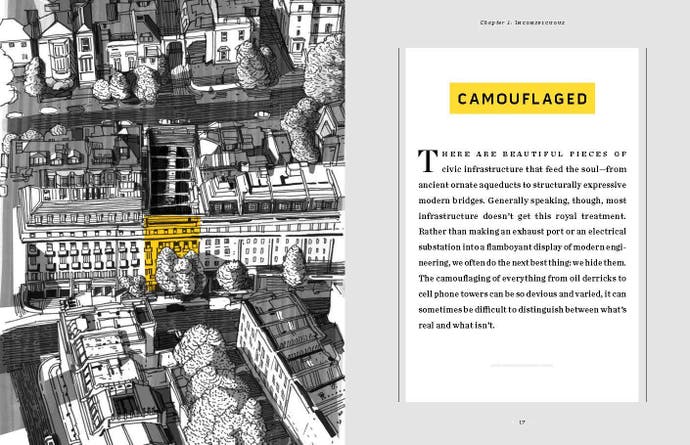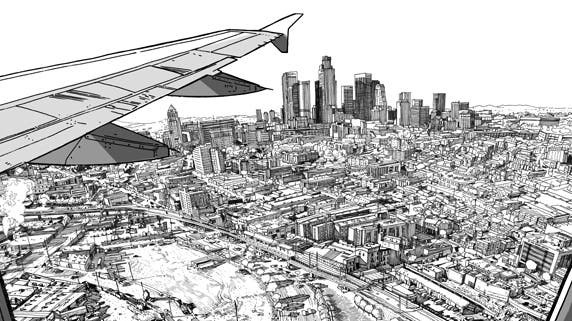The 99% Invisible City has a surprising amount to say about games
The book of the podcast is a proper treat.
The 99% Invisible City, a new book by Roman Mars and Kurt Kohlstedt et al, belongs on the shelf next to Geoff Manaugh's electrifying A Burglar's Guide to the City. They're very different sizes, so hang onto something because it's going to look weird, but don't sweat it too much: a bookshelf should be a jumble, a skyline.
This one won't spend long on the shelf anyway. Normally I would review a book after I've finished reading it, but I want this one to last, and I refuse to read it front-to-back in the first place. The 99% Invisible City is a book to have close to hand whenever there is reclining and musing to be done. Keep it by a sofa or a Strandmon.
99% Invisible is one of those podcasts that feels like it has always been there. Whenever it turns out that, astonishingly, I know something interesting, it's always because of this playful and curious series about design and urbanism. Did you know New York is almost without alleyways? Did you know most neon tube lighting is shaped by hand? Did you know about that weird place in Washington State that you can only get to via Canada and which is meant to be where witness protection people get sent? All of this is down to 99% Invisible.
It's a podcast that feels a bit like a club - I suspect that Roman Mars, the creator, fosters this feeling on purpose. What a club! Stories and fascinating information zinging back and forth every week. Now the club has its own book, a lovely hardback you could confidently use to stun an intruder, or to wedge open an unhelpful Norman Door. (The 99% Invisible City belongs on the same shelf as The Design of Everyday Things too, obv.) I loved this book before I even opened it. The onion-layer heft. The black, white and yellow colour scheme. The promise of treats.

Inside, the city and its design are approached from all angles, laid out in large headings like Inconspicuous and Conspicuous and Infrastructure and Architecture, and sliced and diced further into things like Ubiquitous, Signage, and Interventions. The joy of listening to the podcast is you never quite know where you're going to be taken next. That's why I think you should resist the urge to go front-to-back here. Fan, ruffle, and then leap in.
Just now I read a proper horror story about revolving doors, and then a thing about the first proper locks and the competition to crack them, and another thing about fire escapes which reminded me how useless they are for many people with disabilities. That's the pleasure of dipping in - you visit one page and then you read a cluster of little pieces all on the same topic. And then you move elsewhere. It's like subway hopping between neighborhoods.
Most of the little essays here are like this: perfect for five minutes. But then five minutes becomes ten, twenty and you're giddy and wonderfully lost. Don't read this if you're properly subway hopping, I think: lots of missed stops.

Talking of missing things, I've listened to the podcast for years, but it was only as I've been reading the book that I think I've finally understood why the work of this team who look at design and architecture and the world around us, why this work they do feels so relevant for someone who spends their days playing video games. The subtitle for the book talks about the "hidden world of everyday design", and I've realised, I think, that if you play games a lot, inside the games you play, a lot of these everyday things aren't very hidden anymore.
Interesting aspects of the landscape are often 99 percent visible in games, in other words. Games seem to put us into a headspace where we are almost comically attuned to spot and fixate on the things that are written about in this book. Locks and keys, fire escapes and desire paths, the way cities create movement and the way they are dynamic and hackable. Games ask us to look at places and systems as things that can be played with, they render detail toylike, and so they make us into hounds for details of all kinds. I can't believe they modeled that fire escape. I can't believe that toilet flushes. I wonder if you can get up on that roof, or get through this door. Here is a singular virtue of games that was up until just now, well, it was 99 percent invisible to me.
The other point that lingers with me is that point about people with disabilities and fire escapes, oddly enough. Now that I think about 99% Invisible, what stands out is not the range of ideas they pull together, but the thoroughness with which they examine them, their unwillingness to be blinkered or ignorant, their desire to bring everybody along with their thoughts. This book is broad and inclusive and serious and thought-provoking and brilliant fun. Remember it come Christmas because you're going to want to get it for everybody.

